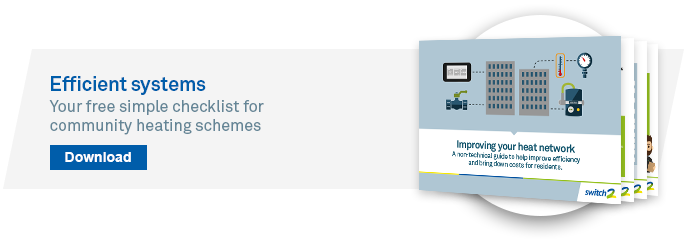It's no surprise that an efficient community heating scheme will provide better benefits and a reliable, consistent service to residents. But how can this be done and what needs to be considered? Our SlideShare investigates.
It's not rocket science... we know that in order to have happy residents, you need to provide:
Reliable, quality and convenient heat.
But, there are many challenges that need to be addressed first:
- Lack of knowledge
- Customer perception and satisfaction
- Poorly operated schemes
- Debt exposure
- Vulnerable residents
All of these can be addressed with engagement, ensuring consistent and quality systems, that most importantly are, affordable.
What is district heating?
District heating is the distribution of heat from a large scale generation to various buildings connected to a network. This could include apartment buildings, commercial outlets, leisure centres and or stadiums.
What is community heating?
Community heating is a centralised heating system that supplies heat and hot water to one building block with more than one heat customer.
The heat network regulations: What is it?
The Energy Efficiency Directive (EED) promotes energy efficiency in the EU to achieve the Commission's 2020 20% headline target on energy efficiency.
The heat network (metering and billing) regulations 2014 implements the requirements of the EED with respect to the supply of distributed heat, cooling, hot water and cold water.
The heat network regulations scope: What's covered?
The Heat Network (Metering and Billing) Regulations apply to buildings that are multiple domestic and or non-domestic multi-occupancy use.
For example:
|
Domestic use |
Non-domestic use |
|
Apartment - must contain:
|
Partitioned space - must contain:
|
The heat supplier: Who is it?
The heat supplier is:
- The supplier to the final customer
- Collecting payment/buying the fuel
- has the authority to fit meters
This could be either the owner, operator/managing agent, service agent or other...it could also be you!
There are three key elements to the heat network regulations
- Duty to notify
- Duty to meter
- Duty to bill
The benefits of final customer metering
Reduces CO2 emissions + Addresses fuel poverty through behavioural change + Performance management + Reduces consumption.
What do you think? An open window in winter, could this be a symptom of flat rate charging for heat?
What smart metering has meant for residents on community heating
- Accurate and timely bills
- Convenient payment options (online, phone or shop)
- In-home display with transparency over spend
- Bringing together cost and control
- Choice
"Because the whole family are out at work all day, only paying for what we use is beneficial to our family. We are spending less on energy." Sheffield City Council resident.
Bringing together cost and control
- Smart metering system
- thermostat & programmer
- Budgeting controls
- Reduces costs for residents
Duty to meter: Point of entry meters
- Applies to district heat networks, not community schemes
- Only required where technically possible
- If not in place you are liable for action after 30th April 2015
Proving the difference: Why use point of entry meter?
- Proving your losses
- Making it fair for residents
- Measure to improve
Measuring performance
- Flow temperatures
- Metering
- Return temperatures
- Pump costs
- Peak loads
CIBSE/ADE CP1 Code of Practice for heat networks
If heat networks are to form a significant part of our future low carbon energy infrastructure in the UK, and meet client and customer expectations, then they need to be designed, built and operated to a high quality. This Code has been produced to assist in achieving that aim by raising standards right across the supply chain.
Streamline your approach
The CIBSE/ADE Code of Practice outlines and ties together the roles and responsibilities of the supply chain on a heat network. Use it to understand who and how a heat network project is tied together - keeping in mind the strategic aims and its goals.
Heat load demand: Why are hear networks different?
It is emphasised that a heat network will only rarely operate at its peak design condition and for the majority of the time the demands will be much lower, typically 10-25% of the peak demand.
The building network: Key issues
A key section for achieving energy efficiency in the Code of Practice is section 3.9. If you don't read anything else - read this section.
It illustrates and explains the importance of insulation on terminal runs and valves and the lack of optimisation will create poor return temperatures.
Bringing together BEMs and metering
Metering and BEMs strategy go hand-in-hand.
Metering is not just about billing... think about temperature flow rates for performance
Portfolio management: A key strategy
If you manage more than one heat network or community heating scheme, think about:
- Setting up league tables and benchmarking
- Connecting buildings for better efficiencies and telemetry
- Manage performance
When a heating scheme is connected together, metering data can be interrogated to provide a clear picture of actual consumption and display room for improvement.
It's about getting customer engaged
- Providing smart equipment
- Anticipating resident needs
- Integrated communication channels with online services
- Customer services, engineers and events
- Feedback & surveys
To summarise: Think about...
- Metering
- Behavioural change
- Reduced consumption
- Inform BEMs strategies
- Cultural change in plant room operations
- Prioritise investments
- Reduced public spend
- Hire the experts



